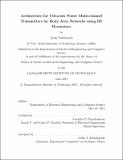| dc.contributor.advisor | Anantha P. Chandrakasan. | en_US |
| dc.contributor.author | Paidimarri, Arun | en_US |
| dc.contributor.other | Massachusetts Institute of Technology. Dept. of Electrical Engineering and Computer Science. | en_US |
| dc.date.accessioned | 2011-10-17T21:30:30Z | |
| dc.date.available | 2011-10-17T21:30:30Z | |
| dc.date.copyright | 2011 | en_US |
| dc.date.issued | 2011 | en_US |
| dc.identifier.uri | http://hdl.handle.net/1721.1/66473 | |
| dc.description | Thesis (S.M.)--Massachusetts Institute of Technology, Dept. of Electrical Engineering and Computer Science, 2011. | en_US |
| dc.description | Cataloged from PDF version of thesis. | en_US |
| dc.description | Includes bibliographical references (p. 99-103). | en_US |
| dc.description.abstract | Body Area Networks (BANs) are gaining prominence for their use in medical and sports monitoring. This thesis develops the specifications of a ultra-low power 2.4GHz transmitter for use in a Body Area Networks, taking advantage of the asymmetric energy constraints on the sensor node and the basestation. The specifications include low transmit output powers, around -10dBm, low startup time, simple modulation schemes of OOK, FSK and BPSK and high datarates of 1Mbps. An architecture that is suited for the unique requirements of transmitters in these BANs is developed. RF Resonators, and in particular Film Bulk Acoustic Wave Resonators (FBARs) are explored as carrier frequency generators since they provide stable frequencies without the need for PLLs. The frequency of oscillation is directly modulated to generate FSK. Since these oscillators have low tuning range, the architecture uses multiple resonators to define the center frequencies of the multiple channels. A scalable scheme that uses a resonant buffer is developed to multiplex the oscillators' outputs to the Power Amplifier (PA). The buffer is also capable of generating BPSK signals. Finally a PA optimized for efficiently delivering the low output powers required in BANs is developed. A tunable matching network in the PA also enables pulse-shaping for spectrally efficient modulation. A prototype transmitter supporting 3 FBAR-oscillator channels in the 2.4GHz ISM band was designed in a 65nm CMOS process. It operates from a 0.7V supply for the RF portion and 1V for the digital section. The transmitter achieves 1Mbps FSK, up to 10Mbps for OOK and BPSK without pulse shaping and 1Mbps for OOK and BPSK with pulse shaping. The power amplifier has an efficiency of up to 43% and outputs between -15dBm and -7.5dBm onto a 50Q antenna. Overall, the transmitter achieves an efficiency of upto 26% and energy per bit of 483pJ/bit at 1Mbps. | en_US |
| dc.description.statementofresponsibility | by Arun Paidimarri. | en_US |
| dc.format.extent | 103 p. | en_US |
| dc.language.iso | eng | en_US |
| dc.publisher | Massachusetts Institute of Technology | en_US |
| dc.rights | M.I.T. theses are protected by
copyright. They may be viewed from this source for any purpose, but
reproduction or distribution in any format is prohibited without written
permission. See provided URL for inquiries about permission. | en_US |
| dc.rights.uri | http://dspace.mit.edu/handle/1721.1/7582 | en_US |
| dc.subject | Electrical Engineering and Computer Science. | en_US |
| dc.title | Architecture for ultra-low power multi-channel transmitters for Body Area Networks using RF resonators | en_US |
| dc.type | Thesis | en_US |
| dc.description.degree | S.M. | en_US |
| dc.contributor.department | Massachusetts Institute of Technology. Department of Electrical Engineering and Computer Science | |
| dc.identifier.oclc | 756456998 | en_US |
